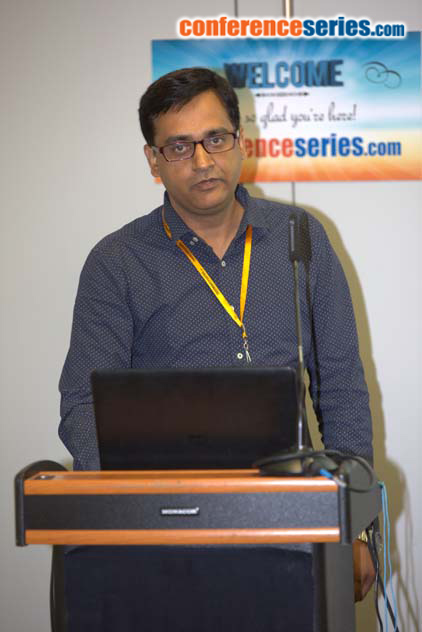
Bhupendra Singh
Indian Institute of Technology, Varanasi, India
Title: Tetravalent metal pyrophosphates and their composites: New electrolytes for intermediate-temperature fuel cells
Biography
Biography: Bhupendra Singh
Abstract
Acceptor-doped tetravalent metal pyrophosphates (MP2O7: M=Sn, Zr, Ce, Ti, etc.) have shown significant proton conductivity of >10-2 S cm-1 in 100-300oC range and are being considered promising electrolytes in proton-conducting ceramic electrolyte fuel cells (PCFCs). But, poor sintering-ability of the tetravalent metal pyrophosphate (TMP) has posed one of the major challenges in their application in PCFCs. In an attempt to utilize the potential of these materials in PCFCs, a number of ways ranging from enhancing sintering behavior to the fabrication of composites have been proposed. Herein, we systematically address some of these aspects and present an overview of developments, and present a report on synthesis and characterization of novel TMP and alkali carbonate (A2CO3; A = Li and/or Na) composites. The TMP-carbonate composites are prepared by mixing indium-doped tin pyrophosphate or yttrium-doped zirconium pyrophosphate with Li2CO3 or an eutectic mixture of Li2CO3-Na2CO3 in different wt.% ratios. The phase composition, microstructure and electrical conductivity of the sintered specimen are analyzed. In addition, the effect of different TMP and A2CO3 phases is investigated. A maximum ionic conductivity of 5.5 × 10−2 S cm−1 at 630°C is observed in this study with a Sn0.9In0.1P2O7-Li2CO3 composite. Based on the literature data, TMP-carbonate composites can be considered to be primarily a proton and oxygen-ion co-ionic conductor and, therefore, have strong potential as electrolytes in fuel cells in 500-700°C range.
Recent Publications
1. Singh B, Bhardwaj A, Gautam SK, Kumar D, Parkash O, Kim IH, Song SJ (2017) Fast ionic conduction in tetravalent metal-pyrophosphate-alkali carbonate composites: New Potential electrolytes for intermediate-temperature fuel cells. Journal of p[ower Sources 345:176-181.
2. Singh B, Bhardwaj A, Gautam SK, Parkash O, Kumar D, Jadhav HS, Song SJ (2017) Synthesis and characterization of MnO-doped titanium pyrophosphates, (Ti1-xMnxP2O7; x=0-0.2), for intermediate-temperature proton-conducting ceramic-electrolyte fuel cells. Ionics DOI: 10.1007/s11581-017-2024-y.
3. Singh B, Duong NMH, Henkensmeier D, Jang JH, Kim HJ, Han J, Nam SW (2017) Influence of different side-groups and cross-links on phosphoric acid doped Radel-based polysulfone membranes for high temperature polymer electrolyte fuel cells. Electrochimica Acta 224:306-313.
4. Im HN, Kim IH, Singh B, Jeon SY, Yoo YS, Song SJ (2017) Isothermal Charge Transport Properties of La0.1Sr0.9Co0.8Fe0.2O3-δ by Blocking Cell Method. Journal of The Electrochemical Society 164:F400-F404.
5. Im HN, Singh B, Hong JW, Kim IH, Lee KT, Song SJ (2017) Pd-YSZ cermet membranes with self-repairing capability in extreme H2S conditions. Ceramics International 43:2291-2296.
6.Singh B, Kim JH, Parkash O, Song SJ (2016) Effect of MnO-doping in tetravalent metal pyrophosphate (MP2O7; M=Ce, Sn, Zr) electrolytes. Ceramics International 42:2983-2989.
7. Kim JH, Singh B, Hong JW, Im HN, Song SJ (2016) Electrical behavior and stability of K2HPO4-KH5(PO4)2-Ce0.9Gd0.1P2O7 composite electrolytes for intermediate temperature proton-conducting fuel cells. Journal of The Electrochemical Society 163:225-229.
8.Im HN, Singh B, Hong JW, Kim IH, Lee KT, Song SJ, (2016) Defect chemistry of highly defective La0.1Sr0.9Co0.8Fe0.2O3-δ by considering oxygen interstitials. Journal of The Electrochemical Society 163:F1588-F1595.
9.Jeon SY, Yoo YS, Singh B, Im HN, Song SJ (2016) Investigation of effect of Al-doping on mass/charge transport properties of La2NiO4+δ by blocking cell method. Journal of The Electrochemical Society 163:F1302-F1307.
10. Lee TR, Lim DK, Singh B, Song SJ (2016) Study of mass transport kinetics in co-doped Ba0.9Sr0.1Ce0.85Y0.15O3-d by electrical conductivity relaxation. Solid State Ionics 289:9-16.


